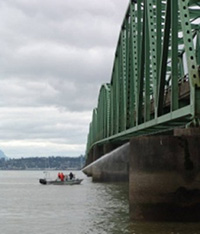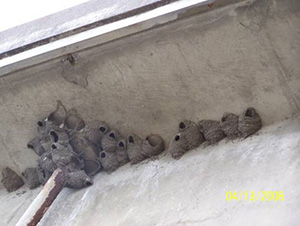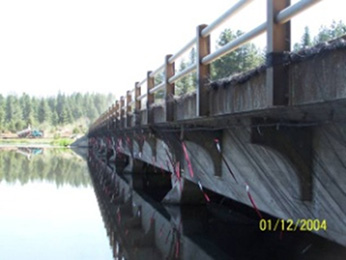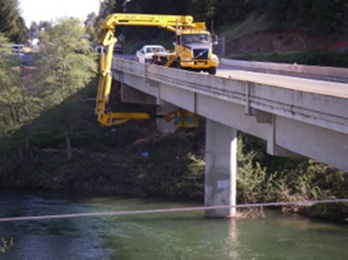Awards
Exemplary Ecosystem Initiatives — 2011
Oregon: The Oregon Department of Transportation (ODOT) Strategy for Migratory Bird Management and Conservation

Figure 1. Poles and water cannons were used to remove inactive nests on bridges that will undergo repair or demolition.
Source: Diane Winterboer, USDA APHIS Wildlife Services

Figure 2. Inactive nests on the underside of bridges were removed.
Source: Diane Winterboer, USDA APHIS Wildlife Services
The Oregon Department of Transportation (ODOT) Strategy for Migratory Bird Management and Conservation builds partnerships and establishes a formal method to minimize transportation project impacts on migratory birds and nesting areas. As migratory birds travel across state lines, ODOT's strategy incorporates collaboration from Federal, State, and private partners, including the U.S. Fish and Wildlife Service (USFWS); U.S. Department of Agriculture, Animal and Plant Health Inspection Service, Wildlife Services (USDA-APHIS-WS); Oregon Department of Fish and Wildlife; and Portland Audubon.
Oregon is home to more than 400 species of migratory birds. Three hundred of these nest directly on or close to transportation infrastructure, including highway right-of-ways and bridges. Most bird species in Oregon are protected under the Migratory Bird Treaty Act (MBTA) of 1918, and some are listed under the Bald and Golden Eagle Protection Act and Federal and State endangered species acts. ODOT's Strategy for Migratory Bird Management and Conservation protects these endangered species by developing methods to simultaneously promote both species preservation and project implementation.
As part of its initiative, ODOT first developed the MBTA Highway Division Directive. This directive contains guidelines for managing migratory birds and nesting areas throughout a project's development, construction, and maintenance. All agency employees are expected to practice due diligence in protecting migratory birds while fulfilling ODOT's mission as a transportation agency.
To further its partnership, ODOT and USDA-APHIS-WS entered into several interagency agreements. As Congress has authorized USDA-APHIS-WS to participate in animal control activities, it assists ODOT staff in migratory bird management practices, including nesting deterrence efforts.
In 2008, ODOT obtained a MBTA special purpose permit for incidental take of specific non-threatened or non-endangered migratory bird species nesting on bridges. This measure allowed ODOT to continue its migratory bird management strategy while maintaining transportation projects. This and subsequent MBTA permits depend upon ODOT's continuing efforts to limit impacts on migratory birds nesting on bridges.
Building on these efforts, ODOT is working to establish an Avian Protection Plan (APP), a voluntary program endorsed by USFWS Law Enforcement to showcase best practices regarding migratory bird protection and conservation. Under the APP, an agency is not required to obtain agreement from the USFWS on every proposed action that is not supported by an MBTA permit that may affect migratory birds. Establishing an APP will help ODOT streamline projects while continuing effective migratory bird management strategies.
For more information, contact Chris Maguire or Frannie Brindle, Oregon Department of Transportation, Geo-Environmental Section, at christine.c.maguire@odot.state.or.us or frances.brindle@odot.state.or.us respectively.

Figure 3: Covering bridges (that will undergo repair or demolition) in netting to prevent birds from nesting on them.
Source: Diane Winterboer, USDA APHIS Wildlife Services

Figure 4: Searching bridges and trees to remove inactive nests in the process of being constructed; the bridges were being repaired or demolished, and the trees had to be removed during the migratory bird nesting season.
Source: Diane Winterboer, USDA APHIS Wildlife Services

